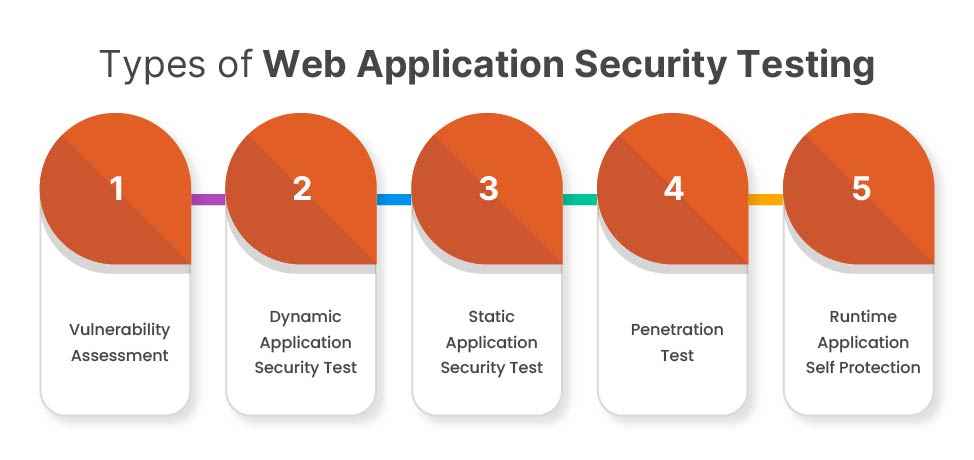Applications are the most favorable medium for hackers who seek to steal data or breach users’ security defenses. Being available 24/7 to users, web applications hold a high chance of becoming a target for hackers trying to seek access to confidential back-end data. According to cybersecurity research, there were more than 3,800 publicly disclosed data breaches, exposing 4.1 billion compromised records. Web applications store a huge amount of data. As the number of transactions on websites continues to rise, organizations must treat comprehensive web application security testing as a mandatory step.
But what actually the term ‘Web Application Security Testing’ mean? Basically, it is the process of checking the security of confidential data from being exposed to unauthorized individuals or entities. The purpose of this security testing is to ensure that the functionality of the website is not being misused or altered by any user. Apart from that, it also ensures that no user holds the authority to deny the functionality of the website to other users.
In order to have the best web application security practices, it is important to have knowledge of the following main key terms:
Table of Contents
What is Web Application Security Testing?
Web application security testing involves identifying, preventing, and addressing vulnerabilities within web applications. This process includes evaluating the application’s code, architecture, and deployment environment to uncover potential security risks such as SQL injection, cross-site scripting (XSS), buffer overflows, and malicious file execution.
As businesses increasingly migrate to the cloud, securing web applications becomes essential to secure sensitive data. Since web applications are frequent targets for malicious attacks, regular testing and proactive protection measures are crucial to minimizing potential threats.
Get in!
Join our weekly newsletter and stay updated
Vulnerabilities In Web Application Security Testing
- Website Spoofing:
An Act of creating a hoax website to mislead users or target the audience of the authenticated website for fraudulent intent.
- URL Manipulation:
Attackers alter or manipulate information in the URL to access confidential data, which is passed through the query string.
- SQL injection:
A computer attack in which malicious code is inserted in a weakly-designed web application and is then passed on to the backend database. As a result, malicious data produces a confidential database query result.
- XSS (Cross-Site-Scripting):
Attackers inject malicious scripts into otherwise trusted websites, causing a security breach. This attack occurs when a cyber-attacker uses a web application to send malicious code to different end-user in the form of a browser-side script.
Types of Web Application Security Testing
When it comes to web application security, there are more than one standard way to perform:

1. Vulnerability Assessment
Automated software performs this type of testing to scan web applications for known vulnerability signatures. It is the process of identifying and prioritizing vulnerabilities in the web application whereas it provides the knowledge, awareness, and risk background check which is necessary to understand.
2. Dynamic Application Security Test
This automated application security test includes dynamic scanning of a live running web application for analyzing the common vulnerabilities which are susceptible to attack. This process of dynamic vulnerability scanning requires a proper setup of the OWASP ZAP testing standard.
3. Static Application Security Test
SAST solutions analyze the web application from “inside out” in a static form. Under this security application approach, both manual and automated testing techniques are involved. It is helpful in identifying bugs without requiring to execution of applications in a production environment. Also, Static Application Security Testing, developers can scan the source code to systematically identify and eliminate existing application security vulnerabilities.
4. Penetration Test
Penetration testing or ethical hacking is the practice of testing web application security in order to identify the security vulnerabilities that can be easily exploited by attackers. It can be performed either automatically or manually. This security testing is best for critical web applications and especially for those that are undergoing major alterations.
5. Runtime Application Self Protection
Under this approach, various techniques are applied to instrument a web application to detect and block attacks in real time. When an application runs live, RASP ensures to protects it from malicious input or behavior by inspecting the app’s performance behavior.
Does Web App Security Testing Help in Reducing the Organization’s Risk?
Every organization has got either one or multiple website applications, which eventually become the scope of potential data and security exploitation on an extremely broad level. Moreover, with developers working day and night on introducing the latest technology and frameworks with the code deployed, they often fail to think of security as a priority.
Cyber attacks like SQL injection, Remote Command Execution, Path Traversal, and XSS can lead to harmful results like access to restricted content, installation of malicious code, compromised user accounts, loss of customer trust, damaged brand reputation, and much more.
Knowing that such attacks not only make web applications vulnerable but also lead to potential damage to the security, best web application security practices offer to preemptively address the security vulnerabilities and take action against them accordingly.
On the other hand, users now are becoming more aware of securing their data and therefore will trust secured web applications with their personal records and financial details, so it is up to the organization to provide them with robust security.
Therefore, continuous security testing is highly crucial for regularly running web applications in order to mitigate potential vulnerabilities by fixing and improving security. As more secure the web application is, the better the brand reputation of an organization.
Always remember that web applications are 100% secure, and it takes only one small vulnerability for a hacker to exploit everything within its reach. With web application security testing tools, one can minimize cyber risks and can have the full trust of customers.
Book Your Free Cybersecurity Consultation Today!
Conclusion
Web applications serve as the backbone of countless business operations — making their security non-negotiable. As threats become more sophisticated and attackers target vulnerabilities in application logic, architecture, or deployment, organizations must adopt a proactive stance. Web application security testing provides a robust defense by identifying, mitigating, and preventing potential exploits before they cause harm.
By implementing a combination of vulnerability assessments, dynamic and static analysis, penetration testing, and runtime protection, organizations can significantly reduce the risk of breaches, data theft, and reputational damage.
FAQs
- What is security testing in a web application?
A web application security test is dedicated to assessing the security posture of a web application. It involves actively analyzing the application to identify potential weaknesses, technical flaws, or security vulnerabilities.
- What are the common vulnerabilities in web applications?
Some of the most common vulnerabilities found in web applications include SQL injection, cross-site scripting (XSS), cross-site request forgery (CSRF), server-side request forgery (SSRF), file inclusion flaws, and command injection attacks.








Leave a comment
Your email address will not be published. Required fields are marked *